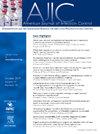Fluoroquinolone consumption and resistance after an Antibiotic Stewardship Team intervention—An interventional study in a single hospital in Southern Poland from 2018 to 2023
IF 3.8
3区 医学
Q2 INFECTIOUS DISEASES
引用次数: 0
Abstract
Background
Fluoroquinolones (FQs) are widely used in empiric treatment with progressively rising resistance. Using in-hospital surveillance and following the recommendations of the US Food and Drug Administration and European Medicines Agency, our Antibiotic Stewardship Team(AST) decided to pursue a restrictive policy for FQ utilization. The aim of this study was to evaluate AST intervention restricting FQ use with preauthorization to determine its effectiveness in decreasing consumption and resistance.
Methods
This study was conducted in a 650-bed hospital in Poland during 2018 to 2019 and 2022 (preintervention) and 2023 (postintervention). Antibiotic consumption (ABC) and antibiotic resistance were compared for both periods. ABC was expressed as a defined daily doses (DDD) per 1,000 pds, and antibiotic resistance was expressed as a resistance rate parameter to FQ in select gram-negative bacilli.
Results
The ABC of all antibiotics varied significantly from 2,987.7 DDD/1,000 pds to 3,741.1 DDD/1,000 pds (2018 vs. 2023). The urology ward showed decreasing FQ consumption from 358.9 DDD/1,000 pds to 43.4 DDD/1,000 pds (from 2018 to 2023, P < .001). A 25% reduction in the resistance rate to FQ was observed, with the greatest difference between 2022 (69.9%) and 2023 (52.6%).
Conclusions
This study demonstrates the effectiveness of FQ restriction and preauthorization in a hospital.

抗生素管理小组干预后氟喹诺酮类药物的使用和耐药性——2018-2023年在波兰南部一家医院进行的一项介入性研究。
背景:在众多种类的抗生素中,氟喹诺酮类(FQ)广泛用于经验性治疗。不幸的是,对FQ的抵抗力正在逐渐上升。根据医院监测数据,并根据美国食品和药物管理局(FDA)和欧洲药品管理局(EMA)的建议,我们的抗生素管理团队(AST)决定对FQ的使用采取限制性政策。本研究的目的是评估预先授权的限制FQ使用的AST干预的影响,以确定其在减少FQ消耗和抗性方面的有效性。方法:本研究于2018-2019年和2022年(干预前,ip前)和2023年(干预后,ip后)在波兰南部一家拥有650个床位的医院进行。在实施预先授权限制FQ使用的干预措施后,比较ip前和ip后的抗生素消耗(ABC)和抗生素耐药性(ABR)。ABC以每1000 pds的DDD (DDD/1000 pds)表示,ABR以基于对FQ联合耐药性的耐药率(RR)参数表示。结果:在分析期内,所有抗生素的总ABC从2018年的2987.7 DDD/1000pds到2023年的3741.1 DDD/1000pds变化显著。泌尿外科病房FQ消耗从2018年的358.9 DDD/1000pds下降到2023年的43.4 DDD/1000pds,差异有统计学意义(R= -0.952, p)。结论:本研究证明了FQ限制和预授权在资源不丰富的医院的有效性,应鼓励其他医院采取此类干预措施。
本文章由计算机程序翻译,如有差异,请以英文原文为准。
求助全文
约1分钟内获得全文
求助全文
来源期刊
CiteScore
7.40
自引率
4.10%
发文量
479
审稿时长
24 days
期刊介绍:
AJIC covers key topics and issues in infection control and epidemiology. Infection control professionals, including physicians, nurses, and epidemiologists, rely on AJIC for peer-reviewed articles covering clinical topics as well as original research. As the official publication of the Association for Professionals in Infection Control and Epidemiology (APIC)

 求助内容:
求助内容: 应助结果提醒方式:
应助结果提醒方式:


